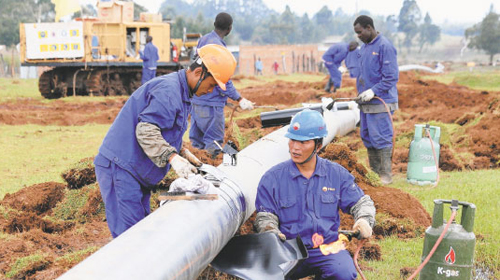Don't miss
- Washington “follows with interest” Morocco’s openness onto Africa (John Kerry)Posted 11 years ago
- The trial of South African Paralympic champion Oscar Pistorius opened in Pretoria on Monday.Posted 11 years ago
- USA welcomes efforts of King Mohammed VI in MaliPosted 11 years ago
- Egypt’s population reaches 94 millionPosted 11 years ago
- Mugabe celebrates his 90thPosted 11 years ago
- Moroccan Monarch to Build a Perinatal Clinic in BamakoPosted 11 years ago
- King Mohammed VI handed a donation of bovine semen for the benefit of Malian breeders.Posted 11 years ago
- Moroccan King’s strategic tour to Africa: Strengthening the will of pan African Solidarity and stimulating the south-south cooperation mechanisms over the continentPosted 12 years ago
- Senior al-Qaida leader killed in AlgeriaPosted 12 years ago
- Libya: The trial of former Prime Minister al-Baghdadi AliPosted 12 years ago
East African Energy Ministers May Decide on Oil Pipeline by October
By African Bulletin on June 30, 2011
 East African energy ministers may decide by October on a proposal to build a natural gas pipeline from Tanzania to Kenya to help meet the region’s rising energy needs, a senior official said.
East African energy ministers may decide by October on a proposal to build a natural gas pipeline from Tanzania to Kenya to help meet the region’s rising energy needs, a senior official said.COWI A/S, a Danish engineering consultant, last week published a study for the East Africa Community (EAC) outlining four economically viable overland routes for the pipeline, ranging in cost between $515 million and $630 million.
“A petroleum council of ministers is next supposed to meet in October, and they will likely then pick the best option,” Peter Kinuthia, a senior energy officer at the EAC said.
The five-nation EAC, comprising Kenya, Tanzania, Uganda, Rwanda and Burundi, is a common market of 126 million people with a combined gross domestic product of $73 billion.
All four routes proposed in the report envisioned the pipeline running about 500 kilometers (310 miles) from Tanzania’s commercial hub of Dar es Salaam through the northern town of Tanga and ending at Kenya’s port city of Mombasa. It could be operational by 2015, and an offshore alternative would be too expensive, the study said.
The region’s governments are seeking to improve energy infrastructure and ensure reliable electricity supplies to cater for economic expansion and population growth.
